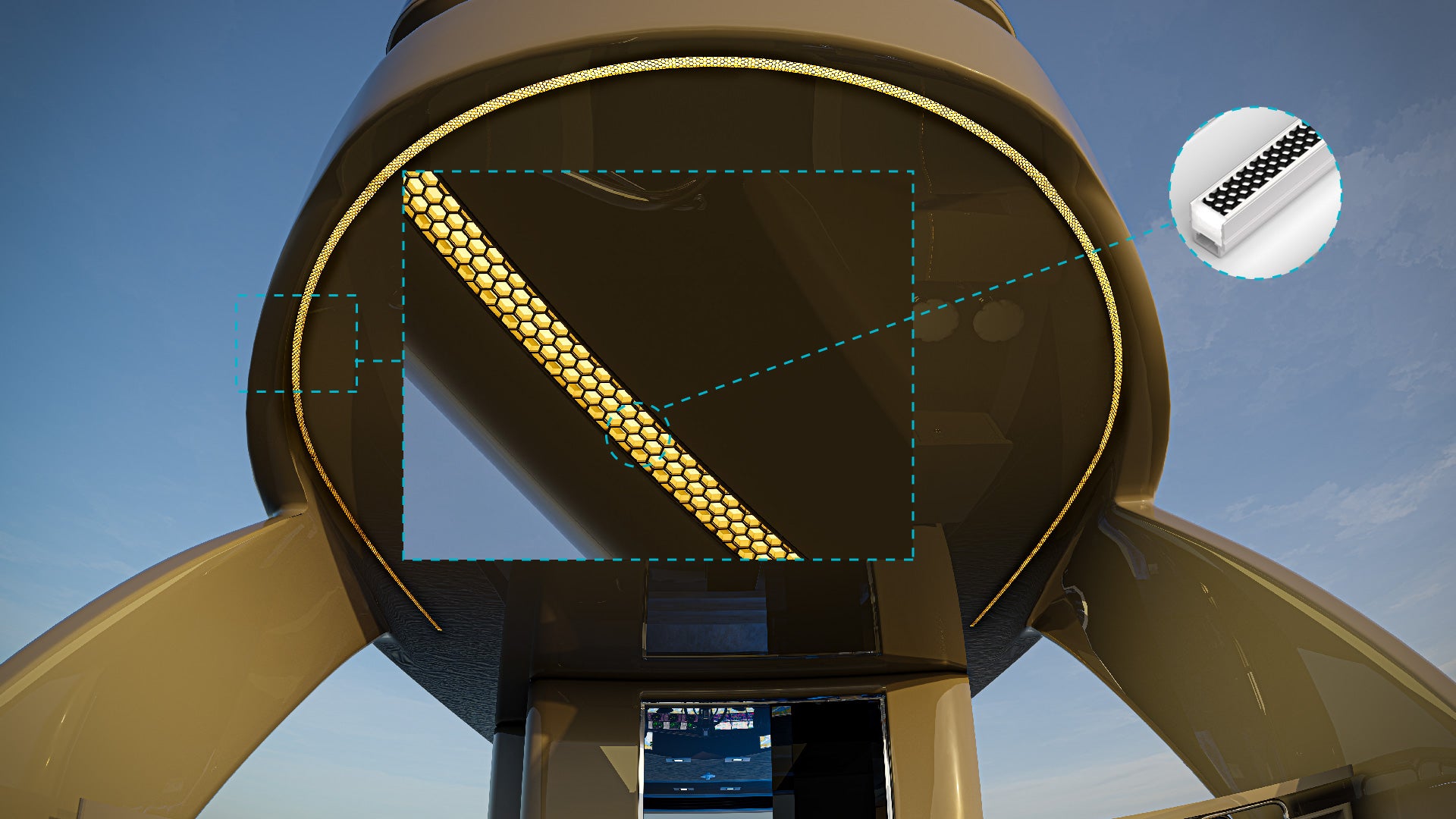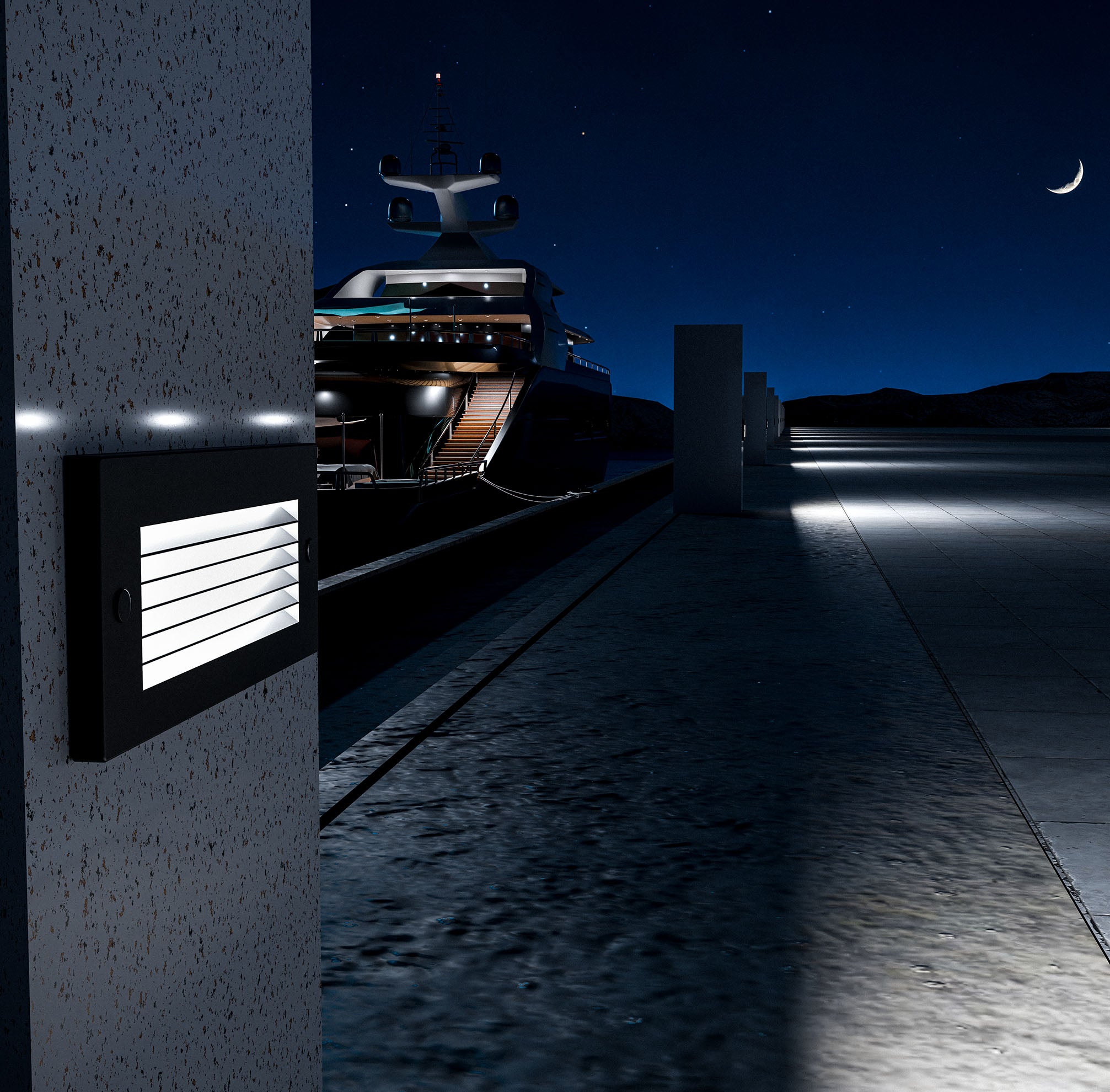What is DC Architecture Lighting?
DC architecture in lighting refers to a building-level power distribution system that delivers low-voltage direct current (DC) directly to lighting fixtures—bypassing the need for individual AC to DC conversions at each light. Instead of relying on traditional AC infrastructure, this architecture centralizes power conversion and sends regulated DC power to connected LED luminaires.
Core Components of a DC Architecture Lighting System
1. Centralized Power Hub (e.g., DCHUB)
Acts as the main distribution point, converting AC power into DC and regulating output to each fixture. It simplifies maintenance and centralizes system control.
2. 57VDC LED Luminaires
Purpose-built fixtures designed to operate on low-voltage DC power, with options like Static CCT or Tunable White to support various lighting needs.
3. Class 2 Cabling
Low-voltage, safe wiring (often 16 AWG) used to distribute power and control signals from the DCHUB to each luminaire. Class 2 wiring reduces installation time and material costs.
4. Integrated Control Systems (e.g., nLight®)
Embedded or networked sensors and control interfaces that allow for zoning, automation, daylight harvesting, occupancy sensing, and more—making the system smart and scalable.
This modular, intelligent approach enables flexible lighting configurations, enhances energy efficiency, and supports sustainability goals in both new and retrofit construction.
Problems with Traditional AC Lighting for DC Fixtures
Despite the fact that most modern lighting—particularly LED fixtures—requires DC power to operate, buildings still receive and distribute AC power. This disconnect introduces several technical and efficiency challenges:
Inefficiency of Rectifiers
Each LED fixture must include a rectifier (within its driver) to convert AC to DC. These components are typically only ~80–90% efficient, leading to energy waste every time the light is turned on.
Energy Loss as Heat
The conversion process releases heat. Over time, this thermal load adds up, especially in fixtures with integrated drivers, where heat builds up near sensitive components.
Risk of Thermal Runaway
Heat can accelerate component degradation, causing even more inefficiency—a feedback loop known as thermal runaway, which can lead to premature fixture failure.
Shortened LED Lifespan and Flickering Issues
Thermal stress and inefficient drivers often result in reduced LED longevity, reliability problems, and common symptoms like flickering or inconsistent light output.
By contrast, DC architecture lighting eliminates the need for these decentralized conversions—reducing waste, increasing system lifespan, and enabling smarter, more sustainable lighting.
Benefits of DC Architecture Lighting
DC architecture lighting offers a range of advantages over traditional AC-based systems—benefits that span energy efficiency, installation simplicity, safety, and future-readiness. As more buildings aim to reduce emissions and adopt smart infrastructure, DC lighting systems provide a practical path forward.
Improved Energy Efficiency
By distributing DC power directly to LED fixtures, DC architecture eliminates the need for decentralized AC to DC conversion at each light. This streamlining significantly reduces:
Energy waste: Avoids conversion losses that typically account for up to 10–20% of energy loss per fixture.
Heat generation: Lower heat output means less thermal stress on components, which improves performance and extends fixture lifespan.
Simplified Installation & Maintenance
DC lighting systems use Class 2 low-voltage cabling, which reduces both material and labor requirements:
No power packs or conduit: Eliminates the need for bulky, high-voltage infrastructure.
Faster commissioning: Pre-configured components and centralized control hubs simplify installation and allow for quicker system setup.
Easier maintenance: Centralized drivers and power conversion points mean fewer failure locations and simpler troubleshooting.
Smart & Tunable White Lighting Capabilities
Modern DC lighting architectures support advanced control features out of the box:
Flexible zoning: Lighting can be grouped and controlled in up to 16 independent channels (or 8 with tunable white).
Scene-setting: Adjust color temperature or brightness based on activities—ideal for classrooms, offices, and wellness spaces.
Integrated sensors: Embedded daylight and occupancy sensors enable automated adjustments that boost comfort and reduce energy use.
Safety Advantages
Class 2 DC systems are inherently safer for installers and occupants:
Lower shock risk: The absence of high-voltage wiring reduces the risk of electric shock and fire hazards.
Compliant with safety codes: Systems like Acuity’s DC2DC meet NEC safety standards for low-voltage lighting distribution.
Supports Renewable Energy Integration
DC lighting aligns seamlessly with the clean energy future:
Solar-ready: DC microgrids and solar panels generate DC electricity, which can be used directly by lighting systems—without inefficient AC conversion steps.
Green building design: DC lighting contributes toward LEED credits and is recognized under LEED Zero certification programs.
As a result, DC architecture lighting isn’t just an energy upgrade—it’s a foundation for smarter, safer, and more sustainable buildings.
Types of DC Power Systems Used in Lighting
DC lighting systems can vary in scale, voltage, and application, but most fall under two primary classifications defined by the National Electrical Code (NEC): Class 2 and Class 4 power systems.
Class 2 Systems
Class 2 DC systems are designed to be low-voltage and inherently safe, with power outputs typically capped at 100 watts per circuit. These systems:
Use standard Class 2 cabling (e.g., 16 AWG)
Eliminate the need for conduit or complex power protection devices
Are ideal for small-scale installations such as classrooms, offices, and retail spaces
Simplify installation and reduce risk of electric shock or fire
Class 4 Systems
Class 4 systems, introduced in the 2023 NEC update, enable fault-managed power distribution at much higher voltages—up to 450VDC—while maintaining safety:
Intelligent transmitters and receivers monitor for cable faults and shut off power if one is detected
Ideal for larger commercial or industrial buildings where power needs to travel greater distances
Extend DC distribution across entire facilities without compromising safety
These systems support scalability while preserving the efficiency and safety benefits of DC lighting.
Centralized vs. Decentralized Systems
Another key distinction in DC architecture is how power is managed and distributed:
Centralized Systems: A single power hub (e.g., DCHUB) converts and regulates DC power for all connected fixtures. This approach simplifies installation and maintenance while ensuring consistent voltage regulation.
Decentralized Systems: Each fixture has its own power conversion and regulation. This often leads to inefficiencies, higher maintenance, and increased risk of thermal issues.
Remote drivers, commonly used in centralized systems, also provide benefits such as improved heat dissipation, easier access for servicing, and support for multi-fixture setups.
Future Outlook and Industry Adoption
DC architecture lighting is no longer a niche concept—it’s emerging as a key component in the evolution of sustainable building design.
Green Building Standards: Programs like LEED Zero and new pilot credits from the U.S. Green Building Council are actively encouraging the use of DC-powered systems for greater energy efficiency.
Smart Infrastructure: As buildings increasingly adopt smart sensors, tunable white lighting, and automation, DC systems offer a more compatible and efficient backbone.
Solar and Microgrid Integration: The rise of solar energy and localized DC microgrids makes DC lighting an ideal match—minimizing conversions, reducing losses, and enabling cost-effective use of renewable energy.
With regulatory support growing and the benefits becoming clearer, the widespread adoption of DC architecture lighting appears not only possible but inevitable—especially in commercial, institutional, and education spaces.
Summary
DC architecture lighting represents a shift toward cleaner, smarter, and more efficient energy infrastructure. By eliminating the inefficiencies of AC to DC conversion, supporting smart control systems, and aligning with renewable energy sources like solar, DC lighting delivers both immediate and long-term value.
From reduced energy waste and maintenance costs to enhanced occupant comfort and flexibility, the advantages are clear. As buildings increasingly prioritize sustainability, safety, and intelligence, DC architecture lighting is poised to become a cornerstone of modern design—powering the future, one fixture at a time.




